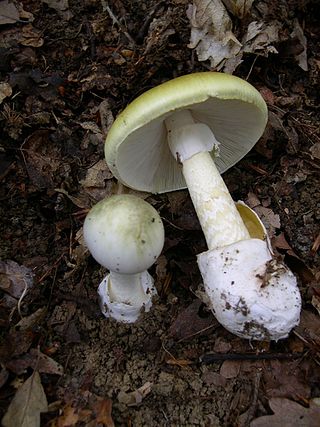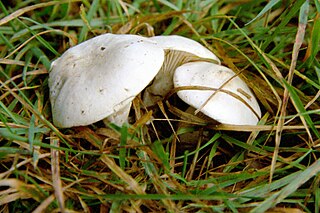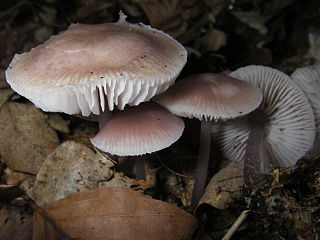
Mushroom poisoning is poisoning resulting from the ingestion of mushrooms that contain toxic substances. Symptoms can vary from slight gastrointestinal discomfort to death in about 10 days. Mushroom toxins are secondary metabolites produced by the fungus.

Clitocybe is a genus of mushrooms characterized by white, off-white, buff, cream, pink, or light-yellow spores, gills running down the stem, and pale white to brown or lilac coloration. They are primarily saprotrophic, decomposing forest ground litter. There are estimated to be around 300 species in the widespread genus.

Lactarius controversus, commonly known as the poplar milkcap, is a large funnel-capped fungus within the genus Lactarius, which are collectively known as 'milk caps'. They all exude milky drops (lactate) from the flesh and gills when damaged.

Entoloma sinuatum is a poisonous mushroom found across Europe and North America. Some guidebooks refer to it by its older scientific names of Entoloma lividum or Rhodophyllus sinuatus. The largest mushroom of the genus of pink-spored fungi known as Entoloma, it is also the type species. Appearing in late summer and autumn, fruit bodies are found in deciduous woodlands on clay or chalky soils, or nearby parklands, sometimes in the form of fairy rings. Solid in shape, they resemble members of the genus Tricholoma. The ivory to light grey-brown cap is up to 20 cm (7.9 in) across with a margin that is rolled inward. The sinuate gills are pale and often yellowish, becoming pink as the spores develop. The thick whitish stem has no ring.

Kuehneromyces mutabilis, commonly known as the sheathed woodtuft, is an edible mushroom that grows in clumps on tree stumps or other dead wood. A few other species have been described in the genus Kuehneromyces, but K. mutabilis is by far the most common and best known.

Hygrophoropsis aurantiaca, commonly known as the false chanterelle, is a species of fungus in the family Hygrophoropsidaceae. It is found across several continents, growing in woodland and heathland, and sometimes on woodchips used in gardening and landscaping. Fruit bodies (mushrooms) are yellow–orange, with a funnel-shaped cap up to 8 cm across that has a felt-like surface. The thin, often forked gills on the underside of the cap run partway down the length of the otherwise smooth stipe. Reports on the mushroom's edibility vary – it is considered poisonous, but has historically been eaten in parts of Europe and the Americas.

Clitocybe dealbata, also known as the ivory funnel, is a small white funnel-shaped basidiomycete fungus widely found in lawns, meadows and other grassy areas in Europe and North America. Also known as the sweating mushroom, or sweat producing clitocybe, it derives these names from the symptoms of poisoning. It contains potentially deadly levels of muscarine.

Tricholoma pardinum, commonly known as spotted tricholoma, tiger tricholoma, tigertop, leopard knight, or dirty trich, is a gilled mushroom widely distributed across North America, Europe, and parts of Asia. It is generally found in beech woodland in summer and autumn. Two subspecies have been described from southern Europe. First officially described by Christiaan Hendrik Persoon in 1801, T. pardinum has had a confusing taxonomic history that extends over two centuries. In 1762, German naturalist Jacob Christian Schäffer described the species Agaricus tigrinus with an illustration corresponding to what is thought to be T. pardinum, and consequently, the name Tricholoma tigrinum has been used erroneously in some European field guides.

Clitocybe nebularis or Lepista nebularis, commonly known as the clouded agaric, cloudy clitocybe, or cloud funnel, is an abundant gilled fungus which appears both in conifer-dominated forests and broad-leaved woodland in Europe and North America. Appearing in Britain from mid to late autumn, it is edible, but may cause gastrointestinal issues.

Marasmius oreades, also known as the fairy ring mushroom, fairy ring champignon or Scotch bonnet, is a mushroom native to North America and Europe. Its common names can cause some confusion, as many other mushrooms grow in fairy rings, such as the edible Agaricus campestris and the poisonous Chlorophyllum molybdites.

Clitopilus prunulus, commonly known as the miller or the sweetbread mushroom, is an edible pink-spored basidiomycete mushroom found in grasslands in Europe and North America. Growing solitary to gregarious in open areas of conifer/hardwood forests; common under Bishop pine along the coast north of San Francisco; fruiting shortly after the fall rains. It has a grey to white cap and decurrent gills.

Inocybe geophylla, commonly known as the earthy inocybe, common white inocybe or white fibercap, is a poisonous mushroom of the genus Inocybe. It is widespread and common in Europe and North America, appearing under both conifer and deciduous trees in summer and autumn. The fruiting body is a small all-white or cream mushroom with a fibrous silky umbonate cap and adnexed gills. An all-lilac variety lilacina is also common.

Tricholoma terreum, commonly known as the grey knight or dirty tricholoma, is a grey-capped mushroom of the large genus Tricholoma. It is found in coniferous woodlands in Europe, and has also been encountered under introduced pine trees in Australia and New Zealand. It is regarded as edible. A 2014 article speculated that it may be poisonous, but Sitta et al. in 2016 published in the same journal a counter article demonstrating the unfounded nature of such speculation.

Ampulloclitocybe clavipes, commonly known as the club-foot or club-footed clitocybe, is a species of gilled mushroom from Europe and North America. The grey brown mushrooms have yellowish decurrent gills and a bulbous stalk, and are found in deciduous and conifer woodlands. Although considered edible, disulfiram-like reactions have been reported after consumption of alcohol after eating this mushroom.

Aspropaxillus giganteus, also Leucopaxillus giganteus, commonly known as the giant leucopax or the giant funnel, is a saprobic species of fungus in the order Agaricales. As its common names imply, the fruit body, or mushroom, can become quite large—the cap reaches diameters of up to 50 cm (20 in). It has a white or pale cream cap, and is funnel-shaped when mature, with the gills running down the length of the stem. Considered by some to be a choice edible when young, this species has a cosmopolitan distribution, and is typically found growing in groups or rings in grassy pastures, roadside hedges, or woodland clearings. It has been shown to contain a bioactive compound with antibiotic properties.

Mycena pura, commonly known as the lilac mycena, lilac bonnet, is a species of mushroom in the family Mycenaceae. First called Agaricus prunus in 1794 by Christian Hendrik Persoon, it was assigned its current name in 1871 by German Paul Kummer. Mycena pura is known to bioaccumulate the element boron.

Infundibulicybe geotropa, also known as the trooping funnel or monk's head, is a funnel-shaped toadstool widely found in Europe and in North America. A large sturdy cream- or buff-coloured funnel-shaped mushroom, it grows in mixed woodlands, often in troops or fairy rings, one of which is over half a mile wide. Although edible, it could be confused with some poisonous species of similar colouration and size.

Paralepista flaccida is a species of mushroom found across the Northern Hemisphere. It is known to form fairy rings.

Infundibulicybe gibba, and commonly known as the common funnel or funnel cap, is a species of gilled mushroom which is common in European woods.

Collybia phyllophila, commonly known as the frosty funnel or the leaf-loving clitocybe, is a fungus in the family Tricholomataceae. Its epithet, meaning leaf-loving comes from its preference for leaf litter. It is common among forests in the Northern Hemisphere, and is poisonous.




















